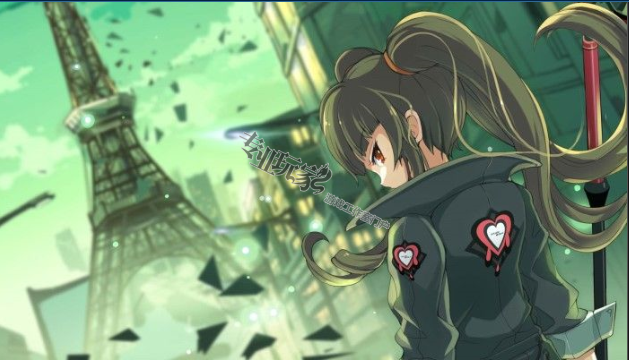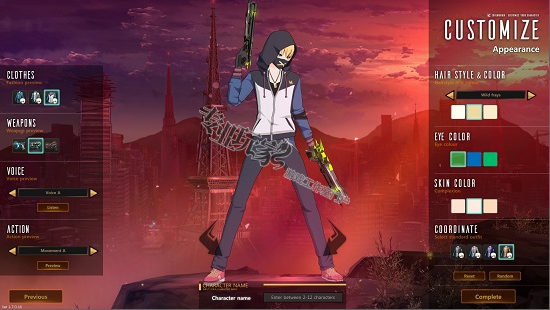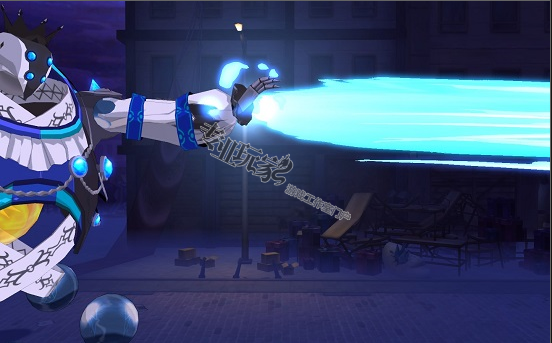御宅族攻击灵魂劳动者降落在西方海岸
2019-09-18
588

上个月Gameforge终于将Soulworker带到西海岸。早在2017年Gamescom上看到这款游戏后,我已经等了将近一年的时间去尝试这款色彩丰富的MMO。现在,同样生动的关闭器已经发布在大众中,我登录了Soulworker查看竞争情况。
对于外行来说,《灵魂工人》是一款受《阿尼米》启发的MMORPG,就像其他许多东方游戏一样,它的发行时间太长了。它结合了超风格化的美学和华丽的战斗系统,这使得它对我们这些钱包被万代南梦公司(Bandai Namco)最新游戏机许可的愈合紧紧压在钱袋里的人具有独特的吸引力。值得庆幸的是,挑选Soulworker并不会影响我在最新刀剑艺术搭配或其他Evangelion模型上的额外支出。Gameforge的最新游戏是一款免费的游戏,这意味着尝试它只需要时间投资。
进入《灵魂工人》,很明显,它的美学是其最突出的特征之一。高度程式化的单元格阴影图形充满了明亮的颜色和粗体线条。这可能不是任何工作室触发杰作,但灵魂工人的人口可以直接从一个顶级动画工作室的细胞。从可玩的角色,翻身乞求关注的柯基犬,到等待的巨大boss大战,一切都是令人印象深刻的喜悦。《灵魂工人》的天启叙事与我所见过的一些最炫的动画形成了鲜明的对比,这种骇人的风格唤起了我内心深处的御宅族情结。

老故事
从东方动画中得到启发的不仅仅是图像。跳进《灵魂工作者》,很明显,整体叙事将是一个相当衍生的事件。像许多漫画或动画一样,这款游戏围绕着一个遭受个人悲剧的年轻人展开。陷入昏迷,数年后你醒来,看到的是一个被战争摧毁的世界。不明身份的怪物破坏了周围的一切,你很快就会成为一个不情愿的英雄,一个灵魂工作者。这些不知情的青少年可以,在典型的Shonen时尚,表现出一种内在的力量。这使得主角们可以表演出令人难以置信的壮举,并给他们的肩上增加了不寻常的负担。这是一种常见的故事弧在这种形式的媒体,并遵循我们不情愿的英雄,因为他们努力寻找自己的位置在一个陌生的世界。
任何习惯了在日本期刊上读季节性文章的人都会熟悉这个比喻,就像淹没日间电视的肥皂剧一样,它本身并没有什么问题。高效的作家可以塑造既可爱又吸引人的角色。为了让这款游戏的故事更贴近情感,《狮子》游戏将角色限制在4个以内。Haru, Erwin, Stella和Lily是第一次登录时向玩家展示自己的四个青少年。

人物比喻
《灵魂工人》中的四个可玩角色都有自己的背景故事和旅程。遗憾的是,尽管他们的旅程实际上写得相当好,但文本却非常沉重。在一个过场动画和动画配音演员都很常见的时代,这款游戏严重依赖于任务文本来传达一种符合类型隐喻的叙事,而不会让人感觉像是游戏的补充螺栓。我也发现翻译的质量似乎相当高。一般来说,对话是有意义的,人物是引人入胜的,所有人都有一种特殊的个性,似乎能克服文本的障碍。
每个主要角色也代表了四种截然不同的游戏风格,从Haru相当直观的剑术到Stella更复杂的音乐伴奏。这四款游戏都有一个令人耳目一新的独特吸引力,但另一方面,角色定制却让人感觉受到了极大的限制。虽然更广泛的设计决策将许多游戏系统绑定到每个英雄身上,但很明显,定制选项的数量令人失望。正如我在最初的印象中所指出的,像Black Desert Online这样的游戏允许玩家从数百万种潜在的排列中选择,操纵每一缕头发。然而,Soulworker提供了一些预先配置的发型、眼睛颜色和肤色。这是一个令人失望的平淡无奇的游戏介绍,坦白地说,它应该有一个更好的开局来吸引玩家。
内容交付
如果角色定制令人不快,我建议您继续。不久你就会在罗科镇(Rocco Town)偶遇自己,这是“灵魂工作者”(Soulworker)系列活动中的第一个。就像En Masse的Closers一样,Soulworker将内容划分为一系列的玩家集散地,这些集散地由所有必要的npc和大量相关的任务组成。《狮子游戏》并没有建立一个庞大的世界来容纳《灵魂工人》的故事,而是将内容分成一系列围绕着玩家中心的地牢。这立即将其与闭包进行比较,这并不完全是不公平的。《灵魂工人》并不是我们所期待的AAA发行版中的大型开放世界MMORPG,而是更接近于大型在线地下城爬虫。

再加上角色创造的捷径,这可能是创造一个大规模开放世界体验的低成本解决方案。在现实中,它提供了大量的PvE内容,玩家可以轻松消费。地下城有三种模式,普通模式,硬模式和狂躁模式。每一个都是各种各样的垃圾暴徒和老板的主人,他们的遭遇总是让人觉得与众不同。无论是满是坚忍苦行的假人的建筑工地,还是被邪恶小丑入侵的郊区街道,这些例子在难度方面都不是特别惊人。两者都不需要,也不需要荒谬的时间投资。如果你只有15分钟,你仍然可以登录到Soulworker,完成一些任务,获取一些战利品,然后继续前进。
切断
进入地牢并参与战斗是灵魂工作者真正开始发光的地方。超程式化的美学和有趣的敌人遭遇仅次于游戏华丽的动作和梦幻般的战斗。字符使用相当标准的WASD移动系统遍历世界,鼠标按钮绑定了主攻击和次攻击。攻击通过装饰屏幕底部的一系列技能得到增强,这些有限的技能集被绑定到一系列数字键上。这一切似乎有些公式化,直到你第一次开始切割敌人。《灵魂工人》融合了动态的组合系统和自由形态的战斗,带来了一种不屈不挠的侵略性,让《刀锋与灵魂》在我第一次体验它的时候给我带来了一股清新的空气。技能可以叠加在一起,创造一系列有效和灵活的组合,让玩家建立自己独特的游戏风格。战斗只是流。它是动态的和迷人的,装饰着那种华丽的效果,让你感觉像一个十足的坏蛋。
去那里和回来
不幸的是,《灵魂工作者》的进展涉及到切割大量相同的敌人。虽然每个地牢都是令人耳目一新的挑战,但有必要磨碎这些相同的遭遇。相对较浅的水平曲线往往会让玩家在遵循主要任务线时毫无准备。再加上关卡控制系统,这就迫使玩家去追逐故事内容,回到《地下城》便能获得全新的体验。这有点令人失望,也有损于原本稳健的晋升体系。
正如你所期望的那样,《灵魂工人》的升级将会给玩家带来一定程度的权力蠕变。具体来说,每一级解锁技能点。这些技能点被用来解锁和最大化一系列的被动和主动技能。与组合系统相结合,这给玩家提供了极大的灵活性,即使是在每个角色的明显角色范围内。
这是由灵魂工作者的一个更独特的进程特点,阿卡莎卡。通常情况下,但不总是作为内容奖励收集,这些卡片在灵魂工作者中表现出NPC、物体或怪物的特征。增加复仇,一个小的HP回复机会,或者增加攻击是一些卡萨卡槽可以提供的奖励。由于只有5个卡槽可用,这一系列的特点,很像游戏中更传统的标题系统,让玩家可以选择将整个游戏风格推向一个特定的方向。
一切都是关于时尚
在这款游戏中,玩家数据对于定义游戏风格同样重要,并且通常与装备相关。齿轮进给系统不会混淆任何不必要的东西。物品可以通过一种直观的方式被掠夺、制作、回收、升级和增强,而这种方式往往会避开游戏真正的奖励系统fashion。在疯狂的boss设计和出色的战斗系统之外,我发现自己又回到了时尚的Soulworker。成就,地下城战利品,每日任务,登录奖励和区域进程都提供奖励,让你得到你的手过多的新衣服。装备可能都是关于属性的,但是设计新衣服的蓝图更受欢迎。制作并不是获得新外观的唯一方法,但在所有情况下,这是另一个地牢的主要动机之一。
这是让你的角色在Haru的嘈杂声中变得独一无二的几种方法之一,也是我发现自己只运行一个地牢的主要原因之一。几十件很酷的服装和配饰充斥着这个手工作坊。尽管内衣的数量引发了不少问题。令我羞愧的是,它甚至成功地让我和我的现实生活中的现金分道扬镳。
事实上,这一切都是为了钱
作为一个自由的游戏玩家,Soulworker拥有一个现金商店系统。意志较弱的时尚达人可能会涉足至少一点消费,这里有一系列健康的化妆品、发烧友、纪念品和VIP套餐。值得称道的是,Soulworker似乎没有挖取战利品的痕迹,这太常见了。虽然我可能对某些物品的价格有些不满,但价格很清楚,这里没有什么是打破游戏规则的。VIP包甚至被证明是一个非常有用的组合津贴,包装即时传送,战利品增强,并增加黄金滴在一个增强的体验助剂。然而,购买VIP套餐确实会让Gameforge的现金商店成为人们关注的焦点。VIP套餐等特定商品的价格与“灵魂现金”的面值之间似乎存在明显的不平衡。许多高价值物品的定价方式要么吸引玩家进行交易,购买大量游戏币,要么将信用卡收起来。
《Soulworker》的盈利模式远非打破游戏规则,只是奇怪地偏离了方向。物品的高成本和现金商店货币的面额意味着想要支持游戏的玩家可能会因为不想花钱而感到沮丧。这是一个奇怪的设置,但随着时间的推移,可以很容易地调整,以达到更合理的平衡。

心和灵魂
总的来说,与Soulworker在一起的时光是我在这类游戏中最愉快的经历之一。它提供了一个相当标准的实例经验,并把它包装在绝对华丽的图形。从一个典型的忧郁的背景音乐飘过启动画面到充满可笑怪物的地牢,这款游戏了解它的观众,并在屏幕上溅满了所有相关的隐喻。战斗在此基础上更进一步。战斗看起来令人难以置信,流畅的移动将穿越地牢的跋涉变成了致命的舞蹈。当Gameforge最终部署PvP,住房,并完成调整游戏的数字时,他们将会发现一件确定的事情。如果你想挥舞一把6英尺长的剑穿过你的敌人,那么灵魂工人现在已经通过Gameforge和Steam离开了。
越来越多的游戏骗子进入到网游行业,专业玩家网骗子查询为你解除后顾之忧。
原文:
Last month Gameforge finally brought Soulworker to western shores. After getting an early glimpse of the game back at Gamescom 2017, I’d been waiting almost a year for another taste of this colorful MMO. Now, with the equally animated Closers already unleashed on the masses, I logged into Soulworker to check out the competition.
For the uninitiated, Soulworker is an anime-inspired MMORPG that has, like so many other eastern titles, been imminently incoming for far too long. It combines the kind of hyper-stylized aesthetic and flashy combat systems that makes it uniquely appealing to those of us whose wallets are firmly wedged beneath the heal of Bandai Namco’s latest console license. Thankfully for me, picking up Soulworker doesn’t have to interfere with my extraneous spending on the latest Sword Art tie-in or another Evangelion model. Gameforge’s latest game is a free to play affair which means that giving it a go should only require a time investment.
Logging into Soulworker, it is apparent that its aesthetic is one of its most prominent features. The heavily stylized, cell shaded graphics are full of bright colors and bold lines. This might not be any Studio Trigger masterpiece, but the population of Soulworker could be ripped straight from the cells of a top-tier anime studio. Everything from the playable characters, the corgis that roll over and beg for attention, to the enormous boss battles that await are an impressive delight. Soulworker’s deeply apocalyptic narrative is set against some of the flashiest animations that I have seen, and this outrageous style just calls out to every inch of my inner Otaku.
The Same Old Story
It is not just the graphics that take a cue from eastern animation. Jumping into Soulworker, it becomes evident that the overarching narrative is going to be fairly derivative affair. Like so many manga or anime, this game revolves around a young adult who suffers a very personal tragedy. Falling into a coma, you awake years later to a world decimated by war. Unidentified monsters lay waste to everything around them and you quickly emerge as a reluctant hero, a Soulworker. These unwitting teens can, in typical Shonen fashion, manifest an inner power. This allows protagonists to perform incredible feats and places an extraordinary burden upon their shoulders. It is a common story arc among this form of media and follows our reluctant hero as they struggle to find their place in an unfamiliar world.
Anybody used to the seasonal slog through Japanese periodicals will be familiar with this trope and like the soap operas that drown day time TV, it is not something that is inherently problematic. Effective writers can craft characters that are both likable and engaging. In a move to make the game’s story more emotionally relevant, Lion games have limited things to four playable characters. Haru, Erwin, Stella, and Lily are the four teenagers that present themselves to players when they first log in.
Character Tropes
Each of the four playable characters in Soulworker has their very own backstory and journey. It is a pity that, although their journey is actually reasonably well written, it is very text heavy. In an age where cut scene narratives and anime voice actors are commonplace, this leans a quite heavily on quest text to deliver a narrative that fits the genre tropes without feeling like a supplementary bolt on to the game. I did also find that the quality of translation seems to be pretty high. Dialogue generally makes sense and characters are engaging, all with a particular personality that seems to overcome the walls of text.
Each of the main characters also represents four very distinct styles of play, from Haru’s fairly intuitive swordplay to Stella’s more complex musical accompaniment. Each of these four has a refreshing and unique appeal, but character customization, on the other hand, feels extremely restrictive. While a broader design decision binds many game systems to each hero, it is abundantly clear that the number of customization options is disappointing. As I noted during my initial impressions, games like Black Desert Online allow players to manipulate individual strands of hair, choosing from millions of potential permutations. Soulworker, however, provides a handful of preconfigured hairstyles, eye colors, skin shades. This is a disappointingly lackluster introduction to a game that frankly deserves a better opening salvo to hook players.
Content Delivery
If the character customization is off-putting, I would urge you to push on. It won’t be long until you bump into yourself in Rocco Town, the first in a series of areas that make up Soulworker. Like En Masse’s Closers, Soulworker divides content into a series of player hubs, adequately populated by all the requisite NPCs and full of relevant quests to get you started. Rather than build a massive sprawling world to house Soulworker’s story, Lion Games segregates content into a series of dungeons that surround player hubs. This immediately draws comparisons to Closers and it is not entirely unfair. Soulworker is not the vast open world MMORPG that we have come to expect from AAA releases, but nearer to a massive online dungeon crawler.
Coupled with the corners cut in the character creation, this could be a low reach solution to producing a massive open world experience. In reality, it provides plenty of PvE content that players can easily consume. Dungeons come in three modes, Normal, Hard, and Manic. Each of these play host to a colorful variety of trash mobs and boss encounters that manage to feel constantly unique. Whether it is a construction yard full of stoic golems or a suburban street invaded by evil clowns, none of these instances are particularly egregious in terms of difficulty. Neither, do they require a ridiculous time investment. If you only have 15 minutes, you can still log into Soulworker, achieve something, grab some loot, and move on.
Cutting Through
Stepping into a dungeon and engaging in combat is where Soulworker really starts to shine. The hyper-stylized aesthetic and interesting enemy encounters come a close second to the game’s flashy moves and fantastic combat. Characters traverse the world using a fairly standard WASD movement system, with a primary and secondary attack bound to the mouse buttons. Attacks are augmented by a series of skills that decorate the bottom of the screen, with this limited skill set bound to a series of numeric keys. This all might seem somewhat formulaic, until you start to slice through enemies for the first time. Soulworker blends a dynamic combo system and free-form combat to bring the sort of unrelenting aggression that made Blade & Soul such a breath of fresh air when I first experienced it. Skills can be stacked together to create a series of effective and flexible combos, allowing players to build their own particular style of play. Combat simply flows. It is dynamic and engaging, decorated with the sort of flashy effects that make you feel like an utter bad-ass.
Getting There & Back Again
Progression in Soulworker, unfortunately, involves slicing through a great deal of these same enemies. While individual dungeons are all refreshingly different challenges, it is necessary to grind these same encounters. A relatively shallow leveling curve tends to leave players decidedly under-prepared when following the main quest line. Coupled with a level gating system, this forces players to chase the story content, returning to dungeons top grind out experience. This is somewhat disappointing and detracts from an otherwise solid progression system.
As you would expect, leveling in Soulworker empowers players with a level of power creep. Specifically, each level unlocks skill points. These skill points are used to unlock and max out a series of passive and active skills. Coupled with the combo system, this gives players great flexibility in the way they play, even within the confines of each character’s obvious role.
This is bolstered by one of Soulworker’s more unique progression traits, the Akasha cards. Generally, but not always, collected as content rewards, these cards manifest a trait of an NPC, object, or monster in Soulworker. Increased retaliation, a small chance of HP regeneration, or increased attack are some of the bonuses that slotting Akasha cards can provide. With only five available card slots, this collection of traits, much like the game’s more traditional title system, gives players the option to nudge overall playstyle in a specific direction.
It's All About the Fashion
Player stats are just as important in defining a playstyle in this particular game and are generally tied to gear. Gear progression systems do not obfuscate anything unnecessarily. Items can be looted, crafted, salvaged, upgraded, and enhanced in an intuitive manner that tends to keep out of the way of the game’s real reward system, fashion. Outside of the crazy boss designs and great combat systems, I find myself coming back to Soulworker for the fashion. Achievements, dungeon loot, daily quests, log in rewards, and zone progression all provide rewards that allow you to get your hands a plethora of new clothes. Gear might be all about stats, but the blueprints that craft new clothes are far more desirable. Crafting is not the only way to get a new appearance, but in all instances, it is one of the major incentives to go grind another dungeon.
This is one of the few ways of making your own character unique among the gaggle of Haru and is one of the primary reasons I find myself running just one more dungeon. Dozens of cool outfits and accessories fill the crafting station. Although the amount of underwear on offer raises more than a few questions. It has even successfully parted me and my real life cash, to my shame.
Actually, It's All About the Money
Being a free to play game, Soulworker, quite reasonably, has a cash shop system. The more weak-willed fashionistas will likely dabble in at least a little spending, and a healthy selection of cosmetic items, buffs, revive tokens, and VIP packages are stocked here. To its credit, Soulworker appears to have no hint of loot box gouging, which is far too common. While I might have some umbrage with the cost of certain items, the cost is clear and nothing here is game-breaking. VIP packages even prove to be an extremely useful mix of perks, wrapping instant teleportation, loot enhancements, and increased gold drops in an enhanced experience booster. Purchasing VIP packages does, however, bring an anomaly of Gameforge’s cash shop into sharp focus. An obvious imbalance between the price of specific items, like VIP packages, and the denominations of Soulcash on sale seems to exist. A number of high-value items appear to be priced in a manner that either entices players to trade up, and buy a large stash of in game currency, or put the credit card away.
The monetization model in Soulworker is far from game breaking, just oddly misaligned. The high cost of items and the denomination of cash shop currencies means players wanting to support the game may end up feeling discouraged from parting with their cash. It’s an odd setup, but one that can easily be tweaked over time to reach a more reasonable balance.
Heart & Soul
On balance, my time with Soulworker has been one of the most enjoyable experiences I’ve had with this type of game. It presents a fairly standard instanced experience and wraps it up in absolutely gorgeous graphics. From the moment a typically melancholy soundtrack drifts over the opening splash screen to the dungeons filled with ridiculous monsters, this game knows its audience and splashes all the relevant tropes all over the screen. Battle builds on this further. Combat looks incredible and the fluid movement turns the trudge through dungeons into a deadly dance. When Gameforge does finally deploy PvP, housing, and finish tweaking the game’s numbers, they will be onto a sure thing. If you want to swing a six-foot sword through your enemies then Soulworker is out now via Gameforge and Steam.
免责声明:部分内容转自其他媒体,转载目的在于为游戏工作室传递更多信息,如因作品内容、版权和其他问题请 联系客服